![The obverse Dutch inscription reads WILLEM III KONING DER NED[ERLANDEN] G[ROOT] H[ERTOG] V[AN] L[UXEMBURG], meaning "William III, King of the Netherlands, Grand Duke of Luxembourg". Wilhelm III Coin.jpg](http://upload.wikimedia.org/wikipedia/en/thumb/5/56/Wilhelm_III_Coin.jpg/220px-Wilhelm_III_Coin.jpg)
The style of the Dutch sovereign has changed many times since the establishment of the Kingdom of the Netherlands due to formations and dissolutions of personal unions, as well as due to marriages of female sovereigns and cognatic successions. [1]
![The obverse Dutch inscription reads WILLEM III KONING DER NED[ERLANDEN] G[ROOT] H[ERTOG] V[AN] L[UXEMBURG], meaning "William III, King of the Netherlands, Grand Duke of Luxembourg". Wilhelm III Coin.jpg](http://upload.wikimedia.org/wikipedia/en/thumb/5/56/Wilhelm_III_Coin.jpg/220px-Wilhelm_III_Coin.jpg)
The style of the Dutch sovereign has changed many times since the establishment of the Kingdom of the Netherlands due to formations and dissolutions of personal unions, as well as due to marriages of female sovereigns and cognatic successions. [1]

The Kingdom of the Netherlands was proclaimed on 16 March 1815, as a state in personal union with the Grand Duchy of Luxembourg under William I, a member of the House of Orange-Nassau who had already inherited a vast number of titles and lands from his ancestors. On 19 April 1839, the Duchy of Limburg joined the union. William I, William II and William III all ruled as kings, grand dukes and dukes. [1]
In 1866, however, the Duchy of Limburg ceased to exist as a separate polity and instead became integrated into the Kingdom of the Netherlands as a province. William III kept the ducal title and passed it on to his successor, Wilhelmina, but she did not succeed him to the throne of Luxembourg, as the country's succession laws provided for strict observance of Salic law. Thus, the reference to the Grand Duchy of Luxembourg disappeared from the style of the Dutch monarch. [1]
The male line of the House of Orange-Nassau ended with the death of William III on 23 November 1890. His only surviving child and successor, Wilhelmina, married Duke Henry of Mecklenburg-Schwerin on 7 February 1901 and, as customary, assumed the feminine form of her husband's title. The title of duchess of Mecklenburg was thus added to her full style. [1] The government did not want the House of Orange-Nassau to become extinct on Wilhelmina's death, [2] and so in 1908 she issued a royal decree conferring the title of prince or princess of Orange-Nassau to her descendants. [3] Her only child, Juliana, was therefore born not only duchess of Mecklenburg but also princess of Orange-Nassau, like previous members of the Dutch royal family. [2]
When Juliana married Prince Bernhard of Lippe-Biesterfeld in 1936, Wilhelmina decreed that her daughter and heir presumptive would assume the title of princess of Lippe-Biesterfeld as customary, but that it would come after her birth title of duchess of Mecklenburg. [4] On 4 September 1948, Wilhelmina abdicated in favour of Juliana, which brought the title of princess of Lippe-Biesterfeld into the full style of the Dutch monarch. At the same time, the title of duchess of Limburg was dropped, Wilhelmina being the last person to hold it. [1]
Like Wilhelmina, Juliana had no sons. She abdicated in favour of Beatrix, the eldest of her four daughters, on 30 April 1980. Beatrix is not a male-line descendant of Duke Henry and thus not a duchess of Mecklenburg. She was the first Dutch monarch in 79 years not to bear the title. Through her father, she is a princess of Lippe-Biesterfeld. [1] [2]
On 30 April 2013, she abdicated in favour of her eldest son, Willem-Alexander, who thus became the first male on the throne in 123 years. He is not a male-line descendant of Prince Bernhard and thus not a prince of Lippe-Biesterfeld. He bears the honorific jonkheer van Amsberg as the son of Claus van Amsberg. [1] [2]
| Period | Full style in Dutch | Full style in English | Sovereign |
|---|---|---|---|
| 16 March 1815 – 19 April 1839 | Bij de Gratie Gods, Koning der Nederlanden, Prins van Oranje-Nassau, Groothertog van Luxemburg, Markies van Veere en Vlissingen, Graaf van Katzenelnbogen, Vianden, Diez, Spiegelberg, Buren, Leerdam en Culemborg, Burggraaf van Antwerpen, Baron van Breda, Diest, Beilstein, de Stad Grave, het Land van Cuyk, IJsselstein, Cranendonck, Eindhoven, Liesveld, Herstal, Warneton, Arlay en Nozeroy, Erf- en Vrijheer van Ameland, Heer van Borculo, Bredevoort, Lichtenvoorde, Het Loo, Geertruidenberg, Clundert, Zevenbergen, Hooge en Lage Zwaluwe, Naaldwijk, Polanen, Sint-Maartensdijk, Soest, Baarn, Ter Eem, Willemstad, Steenbergen, Montfort, Sankt Vith, Burgenbach, Daasburg, Niervaart, Turnhout en Besançon [1] | By the Grace of God, King of the Netherlands, Prince of Orange-Nassau, Grand Duke of Luxembourg, Marquis of Veere and Flushing, Count of Katzenelnbogen, Vianden, Diez, Spiegelberg, Buren, Leerdam and Culemborg, Burgrave of Antwerp, Baron of Breda, Diest, Beilstein, the town of Grave and the lands of Cuyk, IJsselstein, Cranendonk, Eindhoven, Liesveld, Herstal, Warneton, Arlay and Nozeroy, Hereditary and Free Lord of Ameland, Lord of Borculo, Bredevoort, Lichtenvoorde, Het Loo, Geertruidenberg, Clundert, Zevenbergen, Hooge and Lage Zwaluwe, Naaldwijk, Polanen, St Maartensdijk, Soest, Baarn, Ter Eem, Willemstad, Steenbergen, Montfort, St Vith, Bütgenbach, Dasburg, Niervaart, Turnhout and Besançon | William I |
| 19 April 1839 – 23 November 1890 | Bij de Gratie Gods, Koning der Nederlanden, Prins van Oranje-Nassau, Groothertog van Luxemburg, Hertog van Limburg, Markies van Veere en Vlissingen, Graaf van Katzenelnbogen, Vianden, Diez, Spiegelberg, Buren, Leerdam en Culemborg, Burggraaf van Antwerpen, Baron van Breda, Diest, Beilstein, de Stad Grave, het Land van Cuyk, IJsselstein, Cranendonck, Eindhoven, Liesveld, Herstal, Warneton, Arlay en Nozeroy, Erf- en Vrijheer van Ameland, Heer van Borculo, Bredevoort, Lichtenvoorde, Het Loo, Geertruidenberg, Clundert, Zevenbergen, Hooge en Lage Zwaluwe, Naaldwijk, Polanen, Sint-Maartensdijk, Soest, Baarn, Ter Eem, Willemstad, Steenbergen, Montfort, Sankt Vith, Bütgenbach, Daasburg, Niervaart, Turnhout en Besançon [1] | By the Grace of God, King of the Netherlands, Prince of Orange-Nassau, Grand Duke of Luxembourg, Duke of Limburg, Marquis of Veere and Flushing, Count of Katzenelnbogen, Vianden, Diez, Spiegelberg, Buren, Leerdam and Culemborg, Burgrave of Antwerp, Baron of Breda, Diest, Beilstein, the town of Grave and the lands of Cuyk, IJsselstein, Cranendonk, Eindhoven, Liesveld, Herstal, Warneton, Arlay and Nozeroy, Hereditary and Free Lord of Ameland, Lord of Borculo, Bredevoort, Lichtenvoorde, Het Loo, Geertruidenberg, Clundert, Zevenbergen, Hooge and Lage Zwaluwe, Naaldwijk, Polanen, St Maartensdijk, Soest, Baarn, Ter Eem, Willemstad, Steenbergen, Montfort, St Vith, Bütgenbach, Dasburg, Niervaart, Turnhout and Besançon | William I, William II, William III |
| 23 November 1890 – 7 February 1901 | Bij de Gratie Gods, Koningin der Nederlanden, Prinses van Oranje-Nassau, Hertogin van Limburg, Markiezin van Veere en Vlissingen, Gravin van Katzenelnbogen, Vianden, Diez, Spiegelberg, Buren, Leerdam en Culemborg, Burggravin van Antwerpen, Barones van Breda, Diest, Beilstein, de Stad Grave, het Land van Cuyk, IJsselstein, Cranendonck, Eindhoven, Liesveld, Herstal, Warneton, Arlay en Nozeray, Erf- en Vrijvrouwe van Ameland, Vrouwe van Borculo, Bredevoort, Lichtenvoorde, Het Loo, Geertruidenberg, Clundert, Zevenbergen, Hooge en Lage Zwaluwe, Naaldwijk, Polanen, Sint-Maartensdijk, Soest, Baarn, Ter Eem, Willemstad, Steenbergen, Montfort, Sankt Vith, Bütgenbach, Daasburg, Niervaart, Turnhout en Besançon [1] | By the Grace of God, Queen of the Netherlands, Princess of Orange-Nassau, Duchess of Limburg, Marquise of Veere and Flushing, Countess of Katzenelnbogen, Vianden, Diez, Spiegelberg, Buren, Leerdam and Culemborg, Burgravine of Antwerp, Baroness of Breda, Diest, Beilstein, the town of Grave and the lands of Cuyk, IJsselstein, Cranendonk, Eindhoven, Liesveld, Herstal, Warneton, Arlay and Nozeroy, Hereditary and Free Lady of Ameland, Lady of Borculo, Bredevoort, Lichtenvoorde, Het Loo, Geertruidenberg, Clundert, Zevenbergen, Hooge and Lage Zwaluwe, Naaldwijk, Polanen, St Maartensdijk, Soest, Baarn, Ter Eem, Willemstad, Steenbergen, Montfort, St Vith, Bütgenbach, Dasburg, Niervaart, Turnhout and Besançon | Wilhelmina |
| 7 February 1901 – 4 September 1948 | Bij de Gratie Gods, Koningin der Nederlanden, Prinses van Oranje-Nassau, Hertogin van Limburg, Hertogin van Mecklenburg, Markiezin van Veere en Vlissingen, Gravin van Katzenelnbogen, Vianden, Diez, Spiegelberg, Buren, Leerdam en Culemborg, Burggravin van Antwerpen, Barones van Breda, Diest, Beilstein, de Stad Grave, het Land van Cuyk, IJsselstein, Cranendonck, Eindhoven, Liesveld, Herstal, Warneton, Arlay en Nozeray, Erf- en Vrijvrouwe van Ameland, Vrouwe van Borculo, Bredevoort, Lichtenvoorde, Het Loo, Geertruidenberg, Clundert, Zevenbergen, Hooge en Lage Zwaluwe, Naaldwijk, Polanen, Sint-Maartensdijk, Soest, Baarn, Ter Eem, Willemstad, Steenbergen, Montfort, Sankt Vith, Bütgenbach, Daasburg, Niervaart, Turnhout en Besançon [1] | By the Grace of God, Queen of the Netherlands, Princess of Orange-Nassau, Duchess of Limburg, Duchess of Mecklenburg, Marquise of Veere and Flushing, Countess of Katzenelnbogen, Vianden, Diez, Spiegelberg, Buren, Leerdam and Culemborg, Burgravine of Antwerp, Baroness of Breda, Diest, Beilstein, the town of Grave and the lands of Cuyk, IJsselstein, Cranendonk, Eindhoven, Liesveld, Herstal, Warneton, Arlay and Nozeroy, Hereditary and Free Lady of Ameland, Lady of Borculo, Bredevoort, Lichtenvoorde, Het Loo, Geertruidenberg, Clundert, Zevenbergen, Hooge and Lage Zwaluwe, Naaldwijk, Polanen, St Maartensdijk, Soest, Baarn, Ter Eem, Willemstad, Steenbergen, Montfort, St Vith, Bütgenbach, Dasburg, Niervaart, Turnhout and Besançon | |
| 4 September 1948 – 30 April 1980 | Bij de Gratie Gods, Koningin der Nederlanden, Prinses van Oranje-Nassau, Hertogin van Mecklenburg, Prinses van Lippe-Biesterfeld, Markiezin van Veere en Vlissingen, Gravin van Katzenelnbogen, Vianden, Diez, Spiegelberg, Buren, Leerdam en Culemborg, Burggravin van Antwerpen, Barones van Breda, Diest, Beilstein, de Stad Grave, het Land van Cuyk, IJsselstein, Cranendonck, Eindhoven, Liesveld, Herstal, Warneton, Arlay en Nozeray, Erf- en Vrijvrouwe van Ameland, Vrouwe van Borculo, Bredevoort, Lichtenvoorde, Het Loo, Geertruidenberg, Clundert, Zevenbergen, Hooge en Lage Zwaluwe, Naaldwijk, Polanen, Sint-Maartensdijk, Soest, Baarn, Ter Eem, Willemstad, Steenbergen, Montfort, Sankt Vith, Bütgenbach, Daasburg, Niervaart, Turnhout en Besançon [1] | By the Grace of God, Queen of the Netherlands, Princess of Orange-Nassau, Duchess of Mecklenburg, Princess of Lippe-Biesterfeld, Marquise of Veere and Flushing, Countess of Katzenelnbogen, Vianden, Diez, Spiegelberg, Buren, Leerdam and Culemborg, Burgravine of Antwerp, Baroness of Breda, Diest, Beilstein, the town of Grave and the lands of Cuyk, IJsselstein, Cranendonk, Eindhoven, Liesveld, Herstal, Warneton, Arlay and Nozeroy, Hereditary and Free Lady of Ameland, Lady of Borculo, Bredevoort, Lichtenvoorde, Het Loo, Geertruidenberg, Clundert, Zevenbergen, Hooge and Lage Zwaluwe, Naaldwijk, Polanen, St Maartensdijk, Soest, Baarn, Ter Eem, Willemstad, Steenbergen, Montfort, St Vith, Bütgenbach, Dasburg, Niervaart, Turnhout and Besançon | Juliana |
| 30 April 1980 – 30 April 2013 | Bij de Gratie Gods, Koningin der Nederlanden, Prinses van Oranje-Nassau, Prinses van Lippe-Biesterfeld, Jonkvrouwe van Amsberg, Markiezin van Veere en Vlissingen, Gravin van Katzenelnbogen, Vianden, Diez, Spiegelberg, Buren, Leerdam en Culemborg, Burggravin van Antwerpen, Barones van Breda, Diest, Beilstein, de Stad Grave, het Land van Cuyk, IJsselstein, Cranendonck, Eindhoven, Liesveld, Herstal, Warneton, Arlay en Nozeray, Erf- en Vrijvrouwe van Ameland, Vrouwe van Borculo, Bredevoort, Lichtenvoorde, Het Loo, Geertruidenberg, Clundert, Zevenbergen, Hooge en Lage Zwaluwe, Naaldwijk, Polanen, Sint-Maartensdijk, Soest, Baarn, Ter Eem, Willemstad, Steenbergen, Montfort, Sankt Vith, Bütgenbach, Daasburg, Niervaart, Turnhout en Besançon [1] | By the Grace of God, Queen of the Netherlands, Princess of Orange-Nassau, Princess of Lippe-Biesterfeld, Lady of Amsberg, Marquise of Veere and Flushing, Countess of Katzenelnbogen, Vianden, Diez, Spiegelberg, Buren, Leerdam and Culemborg, Burgravine of Antwerp, Baroness of Breda, Diest, Beilstein, the town of Grave and the lands of Cuyk, IJsselstein, Cranendonk, Eindhoven, Liesveld, Herstal, Warneton, Arlay and Nozeroy, Hereditary and Free Lady of Ameland, Lady of Borculo, Bredevoort, Lichtenvoorde, Het Loo, Geertruidenberg, Clundert, Zevenbergen, Hooge and Lage Zwaluwe, Naaldwijk, Polanen, St Maartensdijk, Soest, Baarn, Ter Eem, Willemstad, Steenbergen, Montfort, St Vith, Bütgenbach, Dasburg, Niervaart, Turnhout and Besançon | Beatrix |
| 30 April 2013 – present | Bij de Gratie Gods, Koning der Nederlanden, Prins van Oranje-Nassau, Jonkheer van Amsberg, Markies van Veere en Vlissingen, Graaf van Katzenelnbogen, Vianden, Diez, Spiegelberg, Buren, Leerdam en Culemborg, Burggraaf van Antwerpen, Baron van Breda, Diest, Beilstein, de stad Grave, het Land van Cuyk, IJsselstein, Cranendonck, Eindhoven, Liesveld, Herstal, Warneton, Arlay en Nozeroy, Erf- en Vrijheer van Ameland, Heer van Borculo, Bredevoort, Lichtenvoorde, Het Loo, Geertruidenberg, Klundert, Zevenbergen, Hooge en Lage Zwaluwe, Naaldwijk, Polanen, Sint-Maartensdijk, Soest, Baarn, Ter Eem, Willemstad, Steenbergen, Montfort, St. Vith, Bütgenbach, Niervaart, Daasburg, Turnhout en Besançon [1] | By the Grace of God, King of the Netherlands, Prince of Orange-Nassau, Jonkheer van Amsberg, Marquis of Veere and Flushing, Count of Katzenelnbogen, Vianden, Diez, Spiegelberg, Buren, Leerdam and Culemborg, Burgrave of Antwerp, Baron of Breda, Diest, Beilstein, the town of Grave and the lands of Cuyk, IJsselstein, Cranendonk, Eindhoven, Liesveld, Herstal, Warneton, Arlay and Nozeroy, Hereditary and Free Lord of Ameland, Lord of Borculo, Bredevoort, Lichtenvoorde, Het Loo, Geertruidenberg, Clundert, Zevenbergen, Hooge and Lage Zwaluwe, Naaldwijk, Polanen, St Maartensdijk, Soest, Baarn, Ter Eem, Willemstad, Steenbergen, Montfort, St Vith, Bütgenbach, Dasburg, Niervaart, Turnhout and Besançon | Willem-Alexander |
Shortened versions of the styles, used in preambles:
Titles that have appeared in shortened styles, preceded by "His Majesty" or "Her Majesty" and the monarch's name: [5]
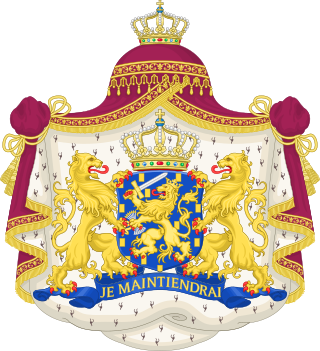
The House of Orange-Nassau is the current reigning house of the Netherlands. A branch of the European House of Nassau, the house has played a central role in the politics and government of the Netherlands and elsewhere in Europe, particularly since William the Silent organised the Dutch Revolt against Spanish rule, which after the Eighty Years' War (1568–1648) led to an independent Dutch state. William III of Orange led the resistance of the Netherlands and Europe to Louis XIV of France, and orchestrated the Glorious Revolution in England that established parliamentary rule. Similarly, Queen Wilhelmina of the Netherlands was instrumental in the Dutch resistance during World War II.

Juliana was Queen of the Netherlands from 1948 until her abdication in 1980.
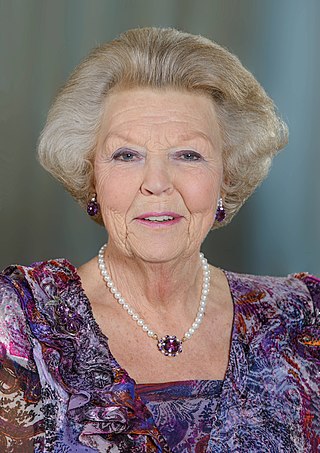
Beatrix is a member of the Dutch royal house who reigned as Queen of the Netherlands from 1980 until her abdication in 2013.

Willem-Alexander is King of the Netherlands.

Prince Constantijn of the Netherlands is the third and youngest son of the former Dutch queen, Beatrix, and her husband, Claus von Amsberg, and is the younger brother of the reigning Dutch king, Willem-Alexander. He is a member of the Dutch Royal House and currently fourth in the line of succession to the Dutch throne behind his nieces.

Wilhelmina was Queen of the Netherlands from 1890 until her abdication in 1948. She reigned for nearly 58 years, making her the longest-reigning monarch in Dutch history, as well as the longest-reigning female monarch outside the United Kingdom. Her reign saw World War I, the Dutch economic crisis of 1933 and World War II.

Princess Christina of the Netherlands was the youngest of four daughters of Queen Juliana of the Netherlands and Prince Bernhard of Lippe-Biesterfeld. She taught singing in New York and was a long-term supporter of the Youth Music Foundation in the Netherlands. Born visually impaired, she worked to share her knowledge of dance and sound therapy with the blind.

Princess Margriet of the Netherlands is the third daughter of Queen Juliana and Prince Bernhard. As an aunt of the reigning monarch, King Willem-Alexander, she is a member of the Dutch Royal House and currently eighth and last in the line of succession to the throne.

Emma of Waldeck and Pyrmont was Queen of the Netherlands and Grand Duchess of Luxembourg as the wife of King-Grand Duke William III. An immensely popular member of the Dutch Royal Family, Queen Emma served as regent for her daughter, Queen Wilhelmina, during the latter's minority from 1890 until 1898.

The Grand Duke of Luxembourg is the head of state of Luxembourg. Luxembourg has been a grand duchy since 15 March 1815, when it was created from territory of the former Duchy of Luxembourg. It was in personal union with the United Kingdom of the Netherlands until 1890 under the House of Orange-Nassau. Luxembourg is the world's only sovereign Grand Duchy and since 1815, there have been nine monarchs, including the incumbent, Henri.

Since 1983, the crown of the Netherlands passes according to absolute primogeniture. From 1814 until 1887, a monarch could only be succeeded by their closest female relative if there were no eligible male relatives. Male-preference cognatic primogeniture was adopted in 1887, though abolished when absolute primogeniture was introduced in 1983. Proximity of blood has been taken into consideration since 1922, when the constitution was changed to limit the line of succession to three degrees of kinship from the current monarch. In a situation where the monarch is succeeded by an eligible aunt or uncle, persons previously excluded could be reintroduced into the line of succession.

Prince Maurits Willem Pieter Hendrik of Orange-Nassau, van Vollenhoven is a member of the Dutch royal family as the eldest son of Princess Margriet of the Netherlands and Pieter van Vollenhoven.

The Order of the Gold Lion of the House of Nassau is a chivalric order shared by the two branches of the House of Nassau.

The monarchy of the Netherlands is a constitutional monarchy whose role and position are governed by the Constitution of the Netherlands. Roughly a third of the Constitution explains the succession, mechanisms of accession and abdication to the throne, the roles and duties of the monarch, the formalities of communication between the States General of the Netherlands, and the monarch's role in creating laws.
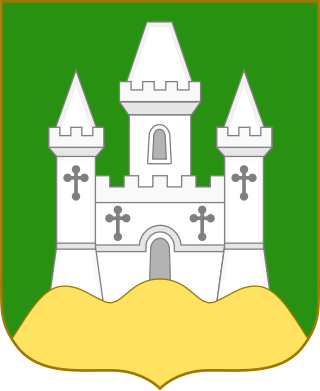
The House of Amsberg is a German noble family that originated in Mecklenburg and whose agnatic head is the present King of the Netherlands, Willem-Alexander. A great-grandson of a blacksmith and grandson of a baker, parish pastor August Amsberg (1747–1820) started calling himself "von Amsberg" in 1795, and the family's right to use this name was confirmed in 1891 by Frederick Francis III, Grand Duke of Mecklenburg-Schwerin. By this permission to use a nobiliary particle, the family effectively became part of the untitled lower nobility of the Grand Duchy of Mecklenburg-Schwerin.

Princess Marie Alexandrine of Saxe-Weimar-Eisenach was the eldest daughter and second child of Charles Alexander, Grand Duke of Saxe-Weimar-Eisenach and his wife Princess Sophie of the Netherlands.

Princess Sophie Louise of Saxe-Weimar-Eisenach was a princess of the House of Saxe-Weimar-Eisenach. She was born in Weimar, the eldest child and only daughter of William Ernest, Grand Duke of Saxe-Weimar-Eisenach, by his second wife, Princess Feodora of Saxe-Meiningen.
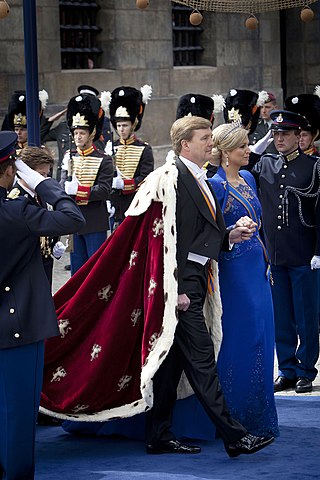
The inauguration of Willem-Alexander took place on 30 April 2013 at the Nieuwe Kerk in Amsterdam. Willem-Alexander ascended the throne immediately following the abdication of his mother Queen Beatrix earlier that day. Willem-Alexander is the first King of the Netherlands since the death of his great-great-grandfather William III in 1890.
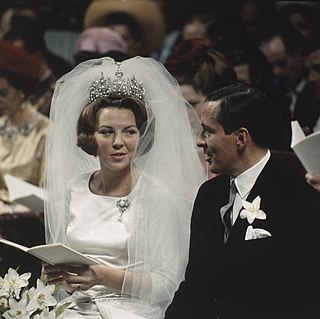
The wedding of Princess Beatrix of the Netherlands and Claus van Amsberg took place on Thursday, 10 March 1966, in Amsterdam, Netherlands. They were married first in a civil ceremony at the Prinsenhof, after which the marriage was religiously blessed in the Westerkerk. The bride was the eldest daughter of Queen Juliana and heir presumptive to the Dutch throne. The groom was an untitled German nobleman. The engagement of the future queen to a German caused an uproar among some Dutch people and the wedding was marred by protests.

The inauguration of Beatrix as Queen of the Netherlands took place on 30 April 1980 at the Nieuwe Kerk in Amsterdam. Beatrix ascended the throne immediately following the abdication of her mother Juliana earlier that day.